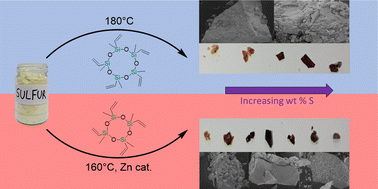Synthesis and characterization of polysulfides formed by the inverse vulcanisation of cyclosiloxanes with sulfur†
Abstract
Inverse vulcanisation stabilizes polysulfide chains through cross-linking. This research focuses on the incorporation of cyclosiloxane cross-linkers containing multiple alkene moieties, namely tetravinyl-tetramethyl-cyclotetrasiloxane (TVTSi) and pentavinyl-pentamethyl-cyclopentasiloxane (PVPSi). Both siloxanes underwent successful inverse vulcanisation and two series of polysulfides were synthesized using different weight percentages of sulfur. Poly(S-r-TVTSi) required at least 20 wt% S in order to generate a solid product whereas poly(S-r-PVPSi) required only 10 wt% S. Interestingly, heating the polysulfide materials caused further cross-linking through the unreacted alkenes. The novel polysulfides were characterized using FTIR and NMR spectroscopies, TGA, DSC and SEM, which revealed that the products formed were inhomogeneous due to the presence of unreacted sulfur. Washing the products with CS2 removed the excess elemental sulfur. All polyslufide products were insoluble in common solvents, but were found to swell to various degrees in non-polar solvents such as hexanes, toluene and benzene, as well as dichloromethane. This led to a preliminary study into their potential use as selective solvent absorption polymers, specifically for the selective removal of hydrocarbons from water. The findings from this research will stimulate further studies towards potential applications as well into other polysulfides synthesized using inorganic cross-linkers.

- This article is part of the themed collections: Polymer Chemistry Emerging Investigators Series and Polymer Chemistry Recent HOT Articles


 Please wait while we load your content...
Please wait while we load your content...